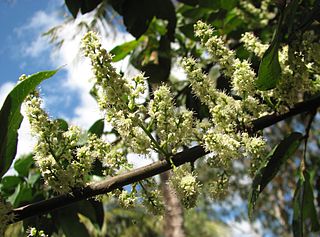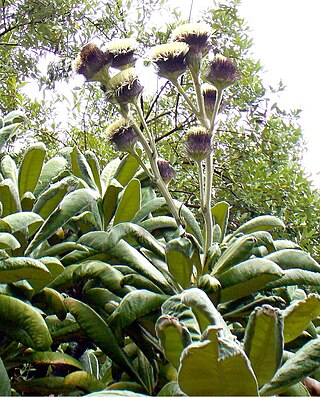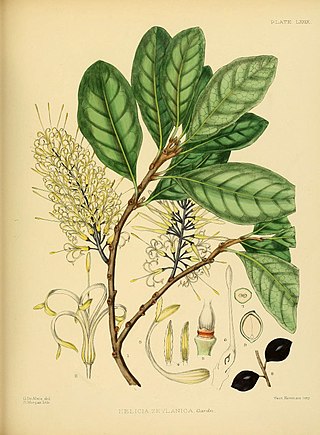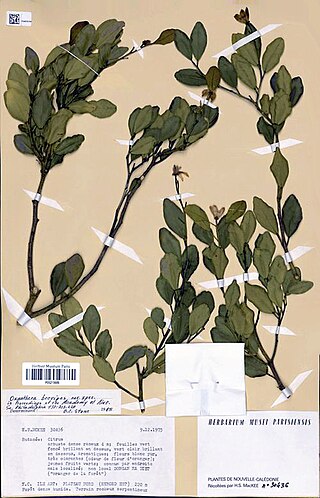
Lauraceae, or the laurels, is a plant family that includes the true laurel and its closest relatives. This family comprises about 2850 known species in about 45 genera worldwide. They are dicotyledons, and occur mainly in warm temperate and tropical regions, especially Southeast Asia and South America. Many are aromatic evergreen trees or shrubs, but some, such as Sassafras, are deciduous, or include both deciduous and evergreen trees and shrubs, especially in tropical and temperate climates. The genus Cassytha is unique in the Lauraceae in that its members are parasitic vines. Most laurels are highly poisonous.

Guioa is a genus of about 78 rainforest tree species known to science, which constitute part of the plant family Sapindaceae. They have a wide distribution, ranging from throughout Malesia, in Burma, Cambodia, Vietnam, Thailand, Malay Peninsula, Borneo, Sumatra, Philippines, Java, Flores, Timor, Sulawesi, Moluccas, New Guinea, further southwards through the east coast of Queensland and New South Wales, Australia and further eastwards to the Pacific Islands, including Tonga, New Caledonia, Fiji and Samoa.

Oldenburgia grandis is a shrub or small, gnarled tree in the family Asteraceae. It occurs in the mountains around Grahamstown in South Africa. It grows to a height of about 5m on sandstone outcrops. It has thick corky bark and large leaves clustered at the ends of branches. The leaves are dark green and leathery, reminiscent of loquat leaves, but generally a good deal larger. The emergent leaves are densely and completely felted with white hair. Most of the felt is lost as the leaf matures, but some persists on under-surfaces. Flowers are white or purplish and borne in large heads some 5- to 12 cm in diameter. The flowerheads are terminal; The same plant may bear solitary heads, plus heads borne in loose, irregular panicles. It is threatened by habitat loss.

Carpoxylon macrospermum is a species of palm tree endemic to Vanuatu, and the only species in the genus Carpoxylon.

Jubaeopsis caffra, the Pondoland palm, is a flowering plant species in the palm family (Arecaceae). It belongs to the monotypic genus Jubaeopsis.

Helicia is a genus of 110 species of trees and shrubs, constituting part of the plant family Proteaceae. They grow naturally in rainforests throughout tropical South and Southeast Asia, including India, Sri Lanka, Indochina, Peninsular Malaysia to New Guinea and as far south as New South Wales.
Homalium rufescens is a species of plant in the family Salicaceae. It is endemic to South Africa. It is commonly called the Small-leaved Brown-Ironwood.

Khaya senegalensis is a species of tree in the Meliaceae family that is native to Africa. Common names include African mahogany, dry zone mahogany, Gambia mahogany, khaya wood, Senegal mahogany, cailcedrat, acajou, djalla, and bois rouge.

Ochrosia brevituba, synonym Neisosperma brevituba, is a species of plant in the family Apocynaceae. It is endemic to New Caledonia.

Ochrosia thiollierei, synonym Neisosperma thiollierei, is a species of plant in the family Apocynaceae. It is endemic to New Caledonia. It is threatened by habitat loss.

Ocotea porosa, commonly called imbuia or Brazilian walnut, is a species of plant in the Lauraceae family. Its wood is very hard, and it is a major commercial timber species in Brazil.
Citrus oxanthera, synonym Oxanthera aurantium, is a species of plant in the family Rutaceae. Sometimes referred to commonly as the orange-flowered oxanthera, it is endemic to New Caledonia.
The false oranges are a group of flowering plants in the Citrus genus, within the family, Rutaceae. They are endemic to New Caledonia.

Oxanthera brevipes is a species of plant in the family Rutaceae. It is endemic to New Caledonia. It was proposed as a novel species by Benjamin C. Stone based on two specimens, distinguished from other false oranges by a non-articulated petiole. The genus Oxanthera has been synonymized with Citrus, but a name in Citrus does not appear to have been published, and Plants of the World Online regards "Oxanthera brevipes" as an unplaced name.
Citrus neocaledonica, synonym Oxanthera neocaledonica, the large leaf oxanthera, is a species of plant in the family Rutaceae. It is endemic to New Caledonia.
Prunus grisea is a species of plant in the family Rosaceae. It is found in Malaysia, the Philippines, Singapore, and Taiwan.
Pseudosalacia streyi is a species of plant in the family Celastraceae, and is the only species in the genus Pseudosalacia. It is endemic to South Africa. It is threatened by habitat loss.

Pseudoscolopia is a genus of plants in the family Salicaceae, which contains a single species, Pseudoscolopia polyantha. It is endemic to South Africa, where it is native to the Cape Provinces and KwaZulu-Natal. It is threatened by habitat loss.

Pleioluma is a genus of flowering plants in the family Sapotaceae. It includes 40 species of evergreen hermaphroditic or gynodioecious trees, reaching up to 25 meters tall.
Oxera baladica is a species of flowering plant in the family Lamiaceae. It comprises two subspecies, both of which are included as vulnerable species on the IUCN Red List:













